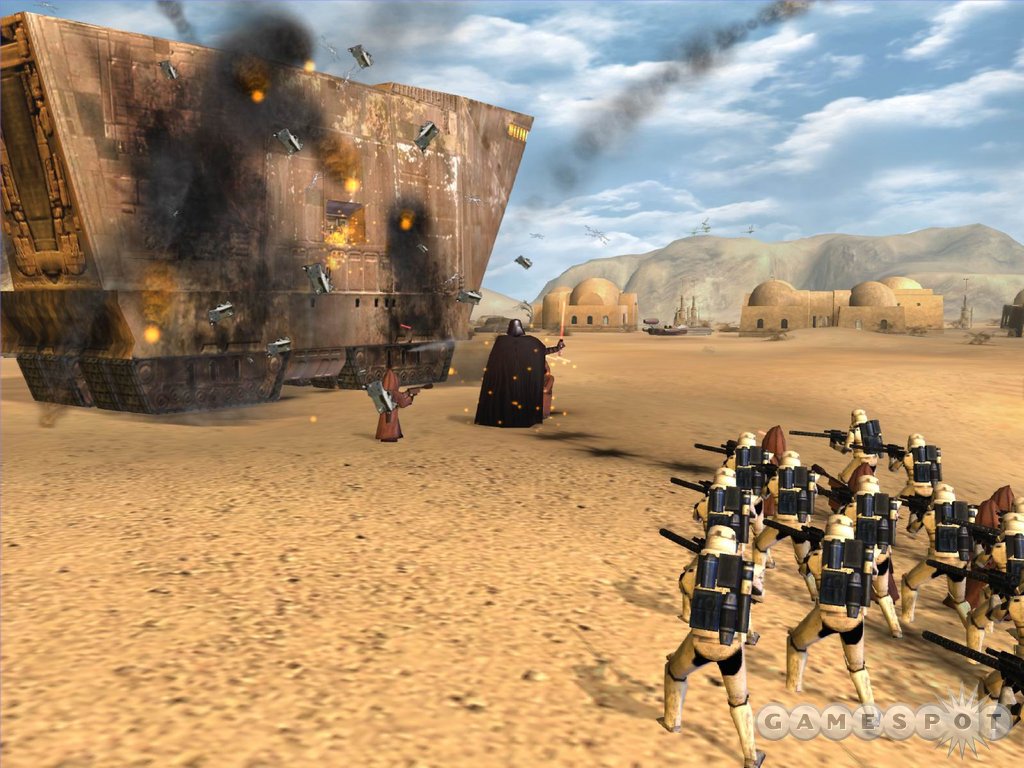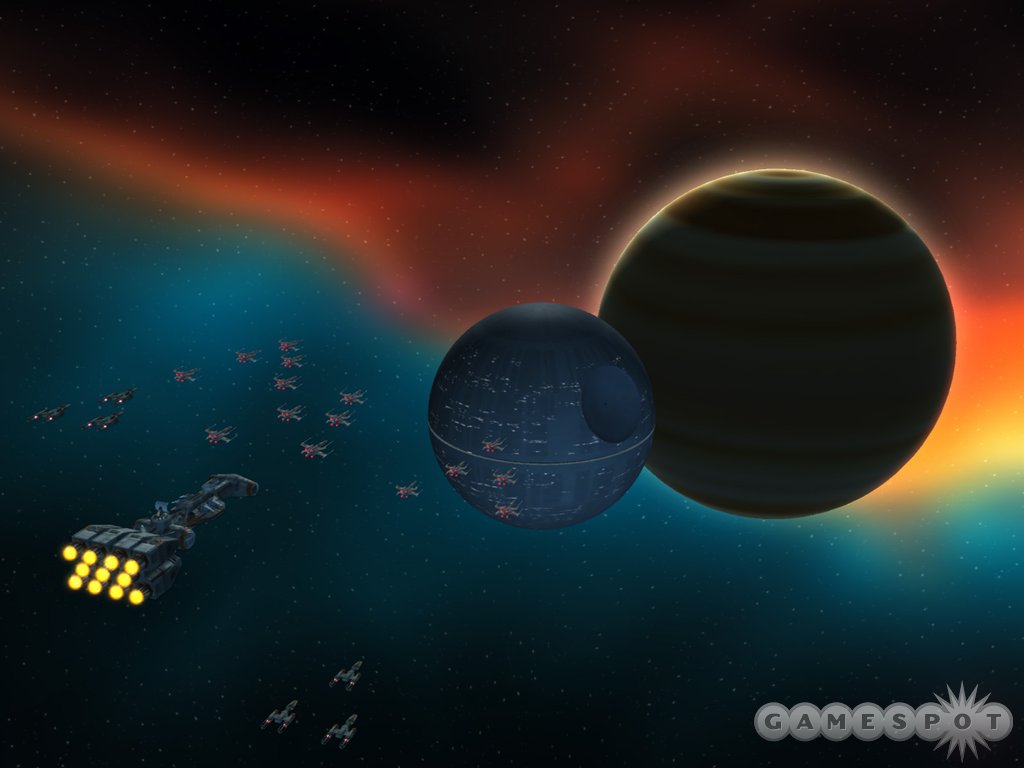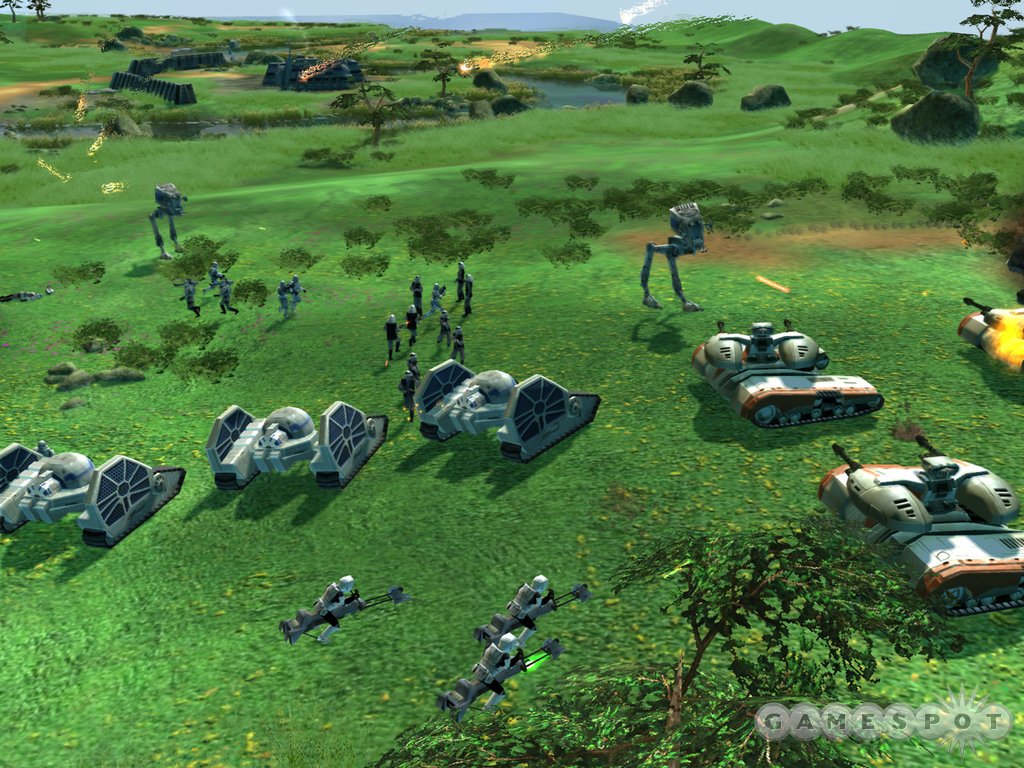Star Wars: Empire at War Q&A - Heroes, Battles, and Blowing Stuff Up With the Death Star
Design director Joe Bostic answers our questions regarding the battle system in this upcoming real-time strategy game.
The Star Wars film saga may now be over with the release of Episode III, but that doesn't mean an end to science fiction's greatest franchise, as creator George Lucas plans to push ahead on other fronts, including gaming. Star Wars: Empire at War is an example of that push. This upcoming real-time strategy game will let you take control of the Galactic Empire or the Rebel Alliance (as seen in the original movie trilogy) and battle it out for control of the galaxy. This means that you'll be able to lead X-Wings, TIE fighters, star destroyers, AT-ATs, and more in land and space battles like the ones you saw in The Empire Strikes Back and Return of the Jedi. Empire at War is a game with a very interesting pedigree, because developer Petroglyph was created by veterans of Westwood Studios, and many of the developers on the game worked on the original Command & Conquer games. We recently had a chance to catch up with Joe Bostic, the design director at Petroglyph, and he answered some of the questions we had from the demo we saw at last month's Electronic Entertainment Expo.

GameSpot: So what's your impression of how the game was received at E3? You had a chance to show it to a lot of people for the first time. What were the reactions? Could you briefly explain to our readers what was shown during the E3 demo?
Joe Bostic: Well, I personally wasn't involved with demos at E3, but those of us who were got nothing but excellent feedback, which is very rewarding. However, I'd be happy to walk you through what they showed everyone.
Our demonstrators showed off the meat of the game, starting with the galactic map, which showed you just how vast the game's Star Wars galaxy is. Playing as the Imperials (you can, of course, choose to play as the Rebellion instead), we moved our fleet to invade the Rebel-occupied Tatooine. Once on Tatooine, three progressively larger skirmishes were shown. The first was a simple battle between stormtroopers and Rebel soldiers, with a rancor thrown into the mix, feasting on anyone foolish enough to get near him. The second battle was a little bigger, with Jawas seen aiding the Rebels, and Darth Vader using Force powers to clear out anyone and anything in his way. From there, we showed the biggest land battle, which featured an attack on a Rebel base backed up by a couple of AT-ATs. We called in a TIE bomber air strike from space to disable the base's shields, but the Rebels were still too strong for us, so we had to retreat. (And that's a great thing about this game. Retreating is sometimes an excellent strategy, especially if you've managed to cause some real damage to the other side.)
Our retreat led to space, where we showed just how easy it is to command anything from a single TIE fighter to the Death Star, which was coming into range. It was up to us to engage the Rebels long enough so that they didn't have a chance to attack our massive new space station. We attacked the hard points (the guns, engines, etc.) on a Mon Calamari, which we eventually destroyed. Soon enough, the Death Star was in range. We asked anyone watching if they wanted us to pull the lever that would activate the superlaser. No one said no. Soon enough, we had commenced the primary ignition, and Tatooine was nothing more than a small asteroid field.
GS: We saw Darth Vader in action, and it was undeniably cool to see the Dark Lord of the Sith on the battlefield. What other major characters can we expect to see in the game? How do you balance Vader and other hero characters so they don't overwhelm the game? And do you create the missions so that if any of them die, you automatically lose, or are there fallback options?
JB: Darth Vader makes quite an impression. The Dark Side of the Force is powerful on the battlefield. He is not alone, but other than him and Obi-Wan Kenobi, we're still not ready to divulge just who else will be out there. All heroes are powerful in their own way, but not so powerful that the battle necessarily revolves around them. The wise player will use them in conjunction with traditional combat units in order to achieve victory, although there are missions where the hero can single-handedly battle the enemy. Heroes are difficult to kill. More often than not, when the hero is about to "die," he escapes to recuperate and fight another day. Star Wars heroes have an uncanny ability to survive difficult situations, and Empire at War remains faithful to that characteristic.

GS: How do you balance the micromanagement involved in switching between land and space battles going on at the same time? Does the computer take over and handle the action for you while you're busy on the other screen? Or do you have any kind of warning system that will tell you that you need to switch to the other battle to make a decision?
JB: This problem is solved by pausing the galactic-level game while in the midst of tactical combat. For the most part, the space at a system must be controlled before a land invasion can begin, which means that space and land combat do not occur simultaneously. However, space and land do interact. Ion cannons can fire up at ships in a space battle, and bombing runs can be called in during land combat.
The Conqueror's Guide to the Galaxy
GS: We saw star destroyers and Calamari cruisers in action at the show, and we saw how different classes of ships travel on different "planes" (fighters travel on different axes than capital ships, for instance). Can we expect to see super star destroyers? How large can fleets eventually be, and how will larger space battles differ in pace and style from larger land battles? 
JB: Fighters and capital ships do travel on "planes" for the most part, but once combat is engaged, there is a bit more freedom. Smaller ships can pass "over" the larger ships, and fighters can dive and weave freely about their targets. Fleets can be large, but there is a point of diminishing returns. Too many ships and it becomes difficult to maneuver, the fleet becomes vulnerable to area-of-effect missiles, and it would be difficult to properly manage each ship to maximum efficiency. Using "just enough" ships to win the battle is best since ships are a scarce resource, the galaxy is large, and one never really knows where the enemy will strike next.
GS: The galactic map seemed very interesting to look at, especially in terms of figuring out the relationships of planets to each other. Are you restricted to traveling in a linear path? In other words, if you're at Planet A and you want to conquer Planet C, do you first need to capture Planet B? Or can your fleets travel between planets independent of the space routes? Could you tell us about the role of trade routes in the game?
JB: Your fleets are not restricted by trade routes and can travel directly to wherever their hyperspace engines can reach. Two factors to keep in mind: Trade routes greatly increase hyperspace speed, and there is a distance limit on a single hyperspace jump. These combine to allow players to freely explore the galaxy, yet still be constrained enough that there will be natural choke points in order to give strategic significance to some systems above their intrinsic value. Another aspect of trade routes, in addition to fleet movement bonus, is that they provide economic rewards if both ends of the trade route are controlled.
GS: We saw the dreaded Death Star in action at E3. We have to ask: How would the Rebels even counter such a superweapon? Do you send a bunch of fighters at it and cross your fingers? What kind of penalties, if any, does the Empire suffer for blowing up entire planets? And how do you balance such a tremendous weapon?
JB: What would the Rebels do when confronted with the prospect of a superweapon that carries firepower greater than half the star fleet? Why, do what any self-respecting Rebellion would do: launch a daring raid to destroy it before it completes production. This isn't the only way to defeat the Death Star. There is that pesky exhaust-port vulnerability. As a Death Star commander, would I really want to blow up just any planet where the Rebels may be infested? Maybe not. The system might better serve the Empire if left intact.
GS: One thing we're wondering about is whether the units are rendered to scale in the game. For example, did you modify unit sizes so that certain units look larger or smaller on the battlefield than they should to make them more clearly visible, or did you go for a 1:1 scale? It seems like space battles aren't to scale, since the fighters looked considerably larger than their counterparts in the movies.
JB: The sizes of units have been adjusted to lessen the extremes for visibility reasons. We are still adjusting sizes of some units, but they will be similar to that shown at E3. The game has almost every aspect controllable through text data files, so changing the scale is possible for the more adventurous technical players.
GS: You haven't discussed multiplayer in depth yet, but do you envision mainly skirmish-type battles in multiplayer mode, or will you be able to play a full campaign-style game in multiplayer? When can we expect more details regarding multiplayer?

JB: Multiplayer consists of skirmish-type battles where one to eight players can fight against each other as either the Rebel or Empire faction. This is a self-contained but enhanced combat experience where elements of production that would otherwise occur at the galactic level are present in the tactical battle. Players can also choose a two-player campaign game that covers the entire galactic struggle.
GS: Finally, where are you in development--what's left to do, and when can we expect the game to ship?
JB: Development of game features is nearing completion. After this, we'll enter the refinement stage where balancing and adjusting occur. This will continue for as long as it takes to create the best Star Wars strategy game experience possible. Expect to see Empire at War in spring 2006.
GS: Thanks, Joe!
Got a news tip or want to contact us directly? Email news@gamespot.com
Join the conversation